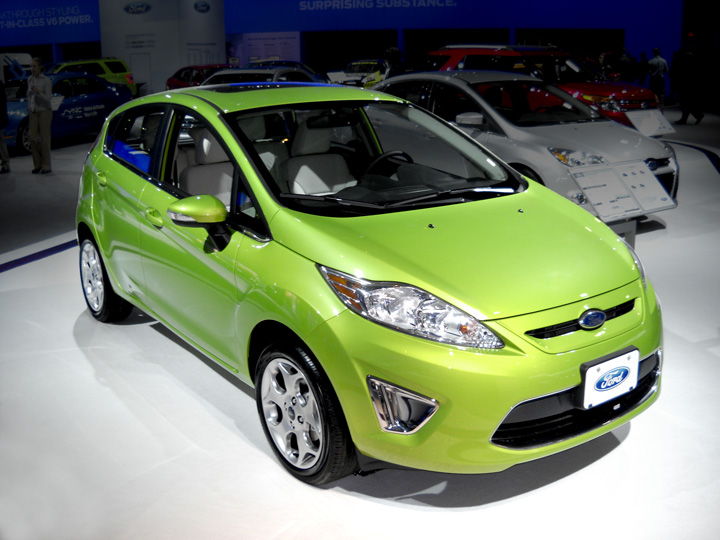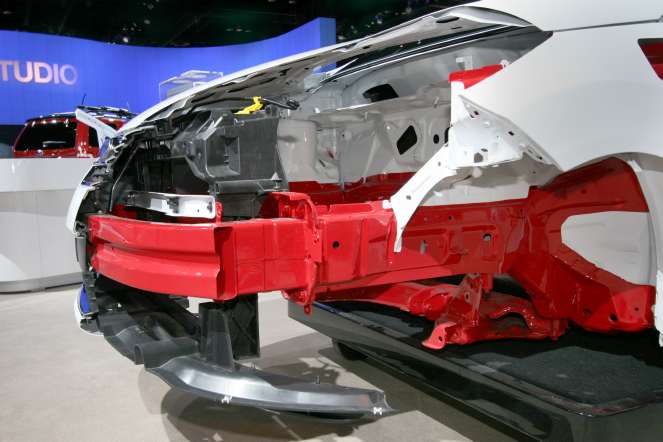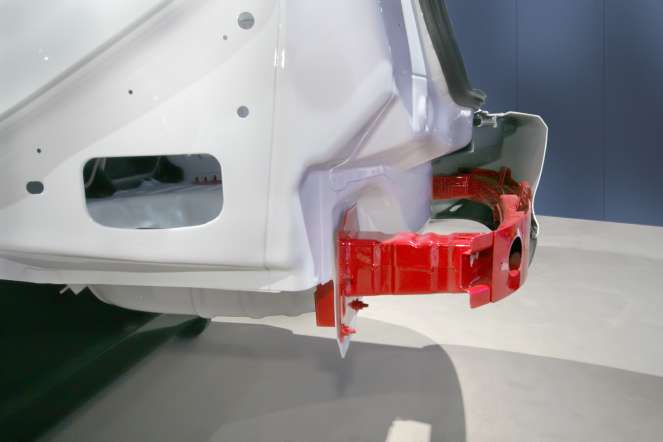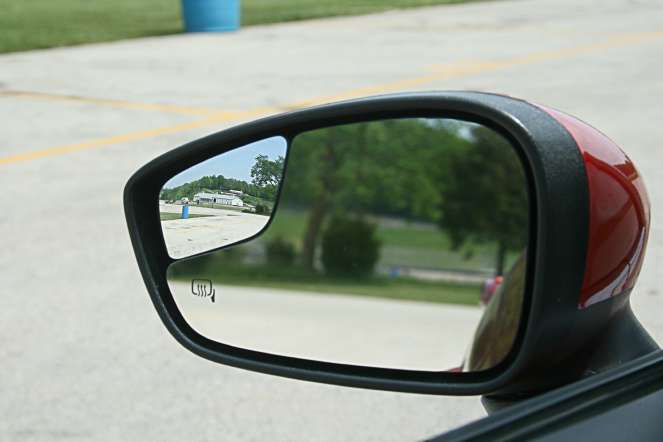Collision Repair And The 2011 Ford Fiesta
 Figure 1 - The 2011 Ford Fiesta does not look anything like the 1978 model.
Figure 1 - The 2011 Ford Fiesta does not look anything like the 1978 model. The 2011 Ford Fiesta is a complete reintroduction of the model name, and one glance will tell you the new Fiesta bears hardly any resemblance to its earlier 1978 namesake (see Figure 1). The Fiesta is based on Ford's new global B-platform, which is planned for use on more vehicles in the next few years. It's available in a four- and five-door body style. Both of the styles are classified as a mini-car. The 2011 Ford Fiesta is the first mini-car to earn a Top Safety Pick from the Insurance Institute for Highway Safety since the introduction of a new roof strength test.
What makes the Fiesta interesting from a collision repair point of view is that it has been referred to as a "study in high-strength steel," which makes up more than half of its structure. For example, the front and rear rails are 600 MPa dual-phase steel. The rocker panel reinforcements are 780 MPa dual-phase steel (see Figure 2). Both the A- and B-pillar reinforcements and the inner B-pillar are boron-alloyed steel, some of the strongest steel to date available on vehicles.
Repair Possibilities
 Figure 2 - The rocker panel reinforcements on the Fiesta are dual-phase 780 steel.Repair possibilities, at least for the rails and the strong reinforcements, are few. But there are some other repairs available. There are bolt-on crush boxes on the ends of both the front and rear rails (see Figures 3 and 4). The crush boxes, as the name implies, are designed to crush in order to absorb collision energy. The crush boxes are not straightened, but easily replaced by bolting on a replacement. More severe collisions that travel rearward of the front crush box or forward of the rear crush box require full replacement of the rail. Due to the DP-600 material, crush zones, and inner reinforcements, a sectioning procedure for the front or rear rails is not available. Only a minor sway in the rails can be straightened.
Figure 2 - The rocker panel reinforcements on the Fiesta are dual-phase 780 steel.Repair possibilities, at least for the rails and the strong reinforcements, are few. But there are some other repairs available. There are bolt-on crush boxes on the ends of both the front and rear rails (see Figures 3 and 4). The crush boxes, as the name implies, are designed to crush in order to absorb collision energy. The crush boxes are not straightened, but easily replaced by bolting on a replacement. More severe collisions that travel rearward of the front crush box or forward of the rear crush box require full replacement of the rail. Due to the DP-600 material, crush zones, and inner reinforcements, a sectioning procedure for the front or rear rails is not available. Only a minor sway in the rails can be straightened.
The boron-alloyed steel A- and B-pillar reinforcements must also be replaced at factory seams, which is typical. The factory workshop (body repair) manual, section 501-35, shows several  Figures 3 - The Fiesta features bolt-on crush boxes as extensions on both the front and rear rails. (Front)sectioning possibilities for the mild steel outer side panels. The outer is available as two replacement service parts, cut just behind the B-pillar. Designated sectioning cut lines are shown in the upper A-pillar, forward of the B-pillar in both the roof rail and rocker panel, and in the quarter panel area. Ford has always preferred a butt joint with backing on outer panel seams, preferably using a portion of the existing or replacement panel as a backing.
Figures 3 - The Fiesta features bolt-on crush boxes as extensions on both the front and rear rails. (Front)sectioning possibilities for the mild steel outer side panels. The outer is available as two replacement service parts, cut just behind the B-pillar. Designated sectioning cut lines are shown in the upper A-pillar, forward of the B-pillar in both the roof rail and rocker panel, and in the quarter panel area. Ford has always preferred a butt joint with backing on outer panel seams, preferably using a portion of the existing or replacement panel as a backing.
Other New Features
The Fiesta has seven airbags, including a driver knee airbag. For a mini-car, seven airbags is considered to be many.
The Fiesta is one of the first Ford vehicles with side airbag pressure-based sensors. These sensors measure the steep and quick increase of pressure within the door cavity in the event of a side  Figures 4 - The Fiesta features bolt-on crush boxes as extensions on both the front and rear rails. (Rear)impact to trigger the side airbag deployment. The sensors do not rely on an airtight seal in the door cavity, as there are air openings in several places in a door shell. The sensors respond to a quick collapsing of the door shell, indicating a side collision. These sensors have up to 30% faster response time than conventional acceleration-based, side-impact sensors. Other side-impact sensors are still required, in the base of the B-pillars, in case the side collision does not impact the front door.
Figures 4 - The Fiesta features bolt-on crush boxes as extensions on both the front and rear rails. (Rear)impact to trigger the side airbag deployment. The sensors do not rely on an airtight seal in the door cavity, as there are air openings in several places in a door shell. The sensors respond to a quick collapsing of the door shell, indicating a side collision. These sensors have up to 30% faster response time than conventional acceleration-based, side-impact sensors. Other side-impact sensors are still required, in the base of the B-pillars, in case the side collision does not impact the front door.
The 2011 Fiesta also features Ford's new blind-spot mirror, which is a secondary convex spotter in the top outer corner of the door mirrors, aimed directly at the driver's blind spot (see Figure 5). When traffic enters the driver's blind spot on either side of the vehicle, it is visible in the secondary convex mirror.
Conclusion
 Figure 5 - The small mirror in the corner of the mirror serves as a view of the blind spot.
The 2011 Ford Fiesta, a rebirth of an old model name for Ford, features several applications of high-strength and ultra-high-strength steel. Front and rear bolt-on crush boxes make them easy to replace in minor frontal collisions. There are several sectioning possibilities for the outer side panels. The Ford Fiesta features seven airbags, pressure-based side airbag sensors, and a new type of blind spot mirror.
Figure 5 - The small mirror in the corner of the mirror serves as a view of the blind spot.
The 2011 Ford Fiesta, a rebirth of an old model name for Ford, features several applications of high-strength and ultra-high-strength steel. Front and rear bolt-on crush boxes make them easy to replace in minor frontal collisions. There are several sectioning possibilities for the outer side panels. The Ford Fiesta features seven airbags, pressure-based side airbag sensors, and a new type of blind spot mirror.
This article first appeared in the December 17, 2010 edition of the I-CAR Advantage Online.
Related I-CAR Courses
Article validated in 2024
-
Toyota/Lexus/Scion Position Statement: Pre- and Post-Repair System Scanning
Thursday, 28 July 2016
As the industry continues to ask if pre- and post-repair system scanning is necessary, Toyota/Lexus/Scion provides their answer.
-
Pre- and Post-Repair System Scanning Statements
Wednesday, 9 January 2019
Are you wondering if a particular OEM or organization has a published statement on pre-repair and post-repair scanning? We have compiled a list of most of the statements on the subject, so you can...
-
ADAS, Calibration, And Scanning Article Hotspot
Monday, 14 January 2019
Since advanced driver assistance systems (ADAS), scanning, and calibration first started becoming relevant, members of the collision repair industry have required as much knowledge as possible on...
-
Honda/Acura Position Statement: Pre- and Post-Repair System Scanning - UPDATE
Wednesday, 22 May 2019
Honda /Acura has updated their position statement on pre- and post-repair scanning to give more clarification on what is expected for scanning.
-
BMW Position Statement: Pre- and Post-Repair System Scanning - UPDATE
Friday, 10 April 2020
BMW has released a position statement related to pre- and post-repair system scanning. The statement applies to All vehicles equipped with on board diagnostics II (OBD II).
-
Quickly Identifying Outer Quarter Panels w/Rolled Hem Flanges
Monday, 5 March 2018
The I-CAR best practice article, Recycled Outer Quarter Panels w/Rolled Hem Flanges has gotten a lot of interest from the collision repair industry. It’s important to know which vehicles are...
-
General Motors Position Statement: Pre- and Post-Repair System Scanning
Friday, 21 October 2016
As the industry continues to ask, are pre- and post-repair scans necessary, General Motors provides their answer.
-
Restraints Wiring Repairs
Monday, 23 May 2016
Over the past few months, we've been sharing OEM position statements on restraints wiring repairs. Now we're bringing them all together in one place for easy reference.
-
FCA/Stellantis Position Statement: Pre- and Post-Repair System Scanning
Thursday, 9 June 2016
FCA/Stellantis has released a position statement related to pre- and post-repair system scanning.
-
Typical Calibration Requirements For Forward Radar Sensors
Wednesday, 12 October 2016
Technicians should be aware of what’s required to keep advanced driver assistance systems (ADAS) running safely after a collision. Whether that be aiming a camera, which can cause a system to not...
-
Structural Sectioning Procedures: Ford/Lincoln - UPDATE
Friday, 19 December 2025
Ask I-CAR receives many technical inquiries referring to sectioning. The collision repair industry wants to know where can you section, does the OEM have a sectioning procedure, and where can I find the...
-
Body Repair Manual Symbols: Hyundai
Wednesday, 17 December 2025
While looking at repair procedures in a body repair manual (BRM) you may notice that symbols are used to indicate specific operations or parts to be used during the repair process. Most BRMs provide a...
-
Body Repair Manual Symbols: Genesis
Wednesday, 17 December 2025
While looking at repair procedures in a body repair manual (BRM) you may notice that symbols are used to indicate specific operations or parts to be used during the repair process. Most BRMs provide a...
-
App-Based Connected Services Considerations: BMW
Wednesday, 10 December 2025
Have you had an experience where the vehicle notified the owner that it was being moved while it was in your repair facility? App-based connected services are available from many vehicle makers and...
-
Digital Key Considerations: BMW
Wednesday, 10 December 2025
The intermingling of technology and automobiles continues, with digital key offerings from most vehicle makers. Digital keys utilize smartphone technology to expand vehicle access and owner...
-
I-CAR Repairers Realm: RTS 2025 Year In Review - Coming Soon
Tuesday, 9 December 2025
I-CAR is having a discussion on the Repairability Technical Support (RTS) 2025 year in review.
-
Mercedes-Benz Vehicles On The RTS OEM Calibration Requirements Search
Thursday, 4 December 2025
Mercedes-Benz models are now listed in the OEM Calibration Requirements Search page on the RTS website. You're going to notice a difference between other vehicle search results and Mercedes-Benz...
-
I-CAR Repairers Realm - New In 2026: Mixed Attachment Methods And Steel Sectioning Recertification - Now Available
Monday, 1 December 2025
I-CAR had a discussion on the new Mixed Attachment Methods course launching in 2026.
-
Repairer Driven News: SCRS OEM Collision Repair Technology Summit Sessions
Monday, 1 December 2025
Repairer Driven News published three articles highlighting safety inspection topics that took place during the Collision Repair Specialists (SCRS) OEM Collision Repair Technology Summit at the 2025...
-
I-CAR Audi Collision Repair And Electromechanical Repair Overview Courses
Tuesday, 25 November 2025
I-CAR has developed courses that provide an overview of collision repair and electromechanical repair for current Audi vehicles.
- 2025
- December 2025 (9)
- November 2025 (11)
- October 2025 (13)
- September 2025 (11)
- August 2025 (12)
- July 2025 (11)
- June 2025 (11)
- May 2025 (11)
- April 2025 (13)
- March 2025 (12)
- February 2025 (11)
- January 2025 (12)
- 2024
- December 2024 (8)
- November 2024 (10)
- October 2024 (13)
- September 2024 (10)
- August 2024 (12)
- July 2024 (11)
- June 2024 (9)
- May 2024 (13)
- April 2024 (12)
- March 2024 (12)
- February 2024 (12)
- January 2024 (9)
- 2023
- December 2023 (8)
- November 2023 (12)
- October 2023 (11)
- September 2023 (11)
- August 2023 (12)
- July 2023 (9)
- June 2023 (11)
- May 2023 (12)
- April 2023 (11)
- March 2023 (12)
- February 2023 (10)
- January 2023 (11)
- 2022
- December 2022 (11)
- November 2022 (12)
- October 2022 (11)
- September 2022 (13)
- August 2022 (11)
- July 2022 (10)
- June 2022 (13)
- May 2022 (11)
- April 2022 (12)
- March 2022 (10)
- February 2022 (11)
- January 2022 (13)
- 2021
- December 2021 (13)
- November 2021 (11)
- October 2021 (13)
- September 2021 (14)
- August 2021 (12)
- July 2021 (15)
- June 2021 (17)
- May 2021 (11)
- April 2021 (14)
- March 2021 (20)
- February 2021 (14)
- January 2021 (14)
- 2020
- December 2020 (13)
- November 2020 (17)
- October 2020 (12)
- September 2020 (14)
- August 2020 (11)
- July 2020 (18)
- June 2020 (14)
- May 2020 (14)
- April 2020 (19)
- March 2020 (12)
- February 2020 (13)
- January 2020 (14)
- 2019
- December 2019 (13)
- November 2019 (19)
- October 2019 (25)
- September 2019 (20)
- August 2019 (22)
- July 2019 (23)
- June 2019 (20)
- May 2019 (19)
- April 2019 (20)
- March 2019 (20)
- February 2019 (18)
- January 2019 (17)
- 2018
- December 2018 (18)
- November 2018 (19)
- October 2018 (17)
- September 2018 (16)
- August 2018 (21)
- July 2018 (20)
- June 2018 (21)
- May 2018 (17)
- April 2018 (19)
- March 2018 (21)
- February 2018 (15)
- January 2018 (20)
- 2017
- December 2017 (13)
- November 2017 (15)
- October 2017 (19)
- September 2017 (20)
- August 2017 (19)
- July 2017 (18)
- June 2017 (19)
- May 2017 (18)
- April 2017 (13)
- March 2017 (18)
- February 2017 (10)
- January 2017 (11)
- 2016
- December 2016 (9)
- November 2016 (14)
- October 2016 (21)
- September 2016 (10)
- August 2016 (11)
- July 2016 (8)
- June 2016 (10)
- May 2016 (5)
- April 2016 (11)
- March 2016 (12)
- February 2016 (10)
- January 2016 (8)
- 2015
- December 2015 (9)
- November 2015 (6)
- October 2015 (8)
- September 2015 (7)
- August 2015 (11)
- July 2015 (7)
- June 2015 (5)
- May 2015 (7)
- April 2015 (8)
- March 2015 (8)
- February 2015 (9)
- January 2015 (10)
- 2014
- December 2014 (12)
- November 2014 (7)
- October 2014 (11)
- September 2014 (10)
- August 2014 (9)
- July 2014 (12)
- June 2014 (9)
- May 2014 (12)
- April 2014 (9)
- March 2014 (6)
- February 2014 (1)
- January 2014 (26)










